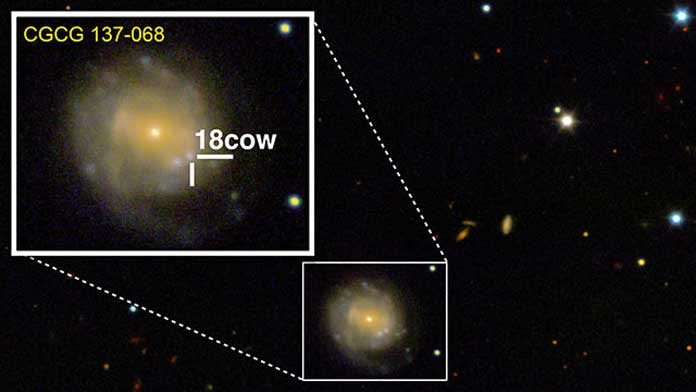Scientists at the Northwestern University have captured the mysteriously bright object that burst in the northern sky this summer. Dubbed AT2018cow or “The Cow,” the object quickly flared up, then vanished almost as quickly.
Using the ATLAS survey’s twin telescopes in Hawaii, scientists found that the spectacularly bright anomaly is located- 200 million light-years away in the Hercules constellation.
Subsequent to combining several imaging sources, including hard X-rays and radio waves, the multi-institutional group estimates that the telescopes caught the correct minute a star crumbled to frame a compact object, for example, a black hole or neutron star. The stellar debris and jetsam, drawing closer and swirling around the object’s event horizon, caused the astoundingly bright glow.
According to astronomers, this rare event will help them understand the physics at play within the first moments of the creation of a black hole or neutron star.
Northwestern’s Raffaella Margutti, who led the research said, “We think that ‘The Cow’ is the formation of an accreting black hole or neutron star. We know from theory that black holes and neutron stars form when a star dies, but we’ve never seen them right after they are born. Never.”
“After it was first spotted, The Cow captured immediate international interest and left astronomers scratching their heads. We thought it must be a supernova. But what we observed challenged our current notions of stellar death.”
Using Northwestern’s access to observational facilities at the W.M. Keck Observatory in Hawaii and the MMT Observatory in Arizona, as well as remote access to the SoAR telescope in Chile, Margutti took a closer look at the object’s makeup. Astronomers examined The Cow’s chemical composition, finding clear evidence of hydrogen and helium, which excluded models of compact objects merging — like those that produce gravitational waves.
Astronomers used viewed the object with x-rays, hard x-rays, radio waves, and gamma rays. These instruments enabled them to continue studying the anomaly long after its initial visible brightness faded.
After ATLAS spotted the object, Margutti’s team quickly obtained follow-up observations of The Cow with NASA’s Nuclear Spectroscopic Telescope Array (NuSTAR) and the European Space Agency’s (ESA) International Gamma-Ray-Astrophysics Laboratory (INTEGRAL) in hard X-rays, with ESA’s XMM-Newton space observatory in soft X-rays and with the Very Large Array in radio waves.
Margutti attributes The Cow’s relative nakedness to potentially unraveling this intergalactic mystery. Although stars might collapse into black holes all the time, a large amount of material around newly born black holes blocks astronomers’ vision. Fortunately, about 10 times less ejecta swirled around The Cow as compared to a typical stellar explosion.
Margutti said, “A ‘lightbulb’ was sitting deep inside the ejecta of the explosion. It would have been hard to see this in a normal stellar explosion. But The Cow had very little ejecta mass, which allowed us to view the central engine’s radiation directly.”
Margutti’s team at Northwestern includes graduate student Aprajita Hajela, postdoctoral fellows Giacomo Terreran, Deanne Coppejans and Kate Alexander (who is a Hubble Fellow), and first-year undergraduate student Daniel Brethauer.
Margutti presented her findings (Jan. 10) at the 233rd meeting of the American Astronomical Society in Seattle. The paper is published in the Astrophysical Journal.
